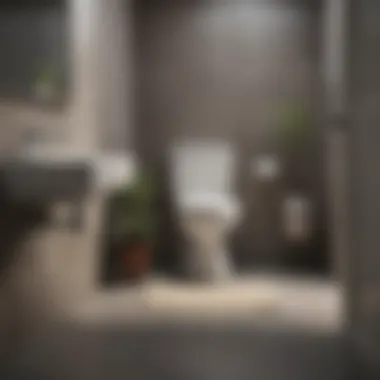Mastering Toilet Clogs: Solutions and Prevention


Intro
Toilets are essential in every home, yet they can be prone to annoying clogs. Understanding the common reasons for blockages can help homeowners manage the situation better. This article will explore practical solutions for unclogging, effective tools, and preventative measures to keep toilets functioning properly.
Every household deals with plumbing issues at some point, making it vital to understand why clogs happen and how to handle them. Knowing the root causes allows for a more effective approach, minimizing stress and frustration during emergencies.
The following sections will discuss architectural features of bathrooms that may contribute to clogs, explore the functionality of various toilet designs, and provide a methodical approach to unclogging your toilet.
Home Features
Bathroom Design Considerations
Bathrooms are unique spaces in homes, often dictated by style and functionality. The layout and fixtures can play a significant role in how plumbing systems perform. Traditional designs, for instance, may have various angles and bends that can lead to easier clogs.
Common bathroom features affecting toilet function:
- Toilet Model: Some toilets have low-flow designs that save water but can struggle with certain waste types.
- Pipe Positioning: Where pipes are installed can affect the flow, creating opportunities for blockages.
- Ventilation: Proper ventilation reduces pressure changes that can affect draining.
Knowing these features can help homeowners choose the right type of toilet and ensure optimal drainage.
Causes of Toilet Clogs
Understanding the reasons for clogs is necessary for effective solutions. Common causes include:
- Excessive Toilet Paper Use: More than the recommended amount can create significant blockages.
- Foreign Objects: Items such as toys or hygiene products can easily block pipes.
- Flushing Improper Items: Items like paper towels or sanitary products often do not break down as toilet paper does.
- Aging Pipes: Older plumbing may collect debris leading to gradual blockages.
These factors are critical when assessing toilet function and can help form strategies to prevent future clogs.
Effective Unclogging Methods
When faced with a clog, immediate action is often required. There are several methods to consider:
- Plunger Use: A reliable tool for most clogs. Ensure it forms a good seal before applying firm, upward and downward motions.
- Drain Snake: A more advanced tool that can reach deeper clogs. Insert gently into the toilet drain to break apart or retrieve obstructive materials.
- Baking Soda and Vinegar: A natural method. Pour a cup of baking soda followed by a cup of vinegar. This may help dissolve certain blockages over time.
Preventative Practices
Proactive measures are essential to keep toilets clear. Consider the following:
- Educate Household Members: Ensure everyone knows what can and cannot be flushed.
- Regular Maintenance: Periodically check the plumbing and clean any potential buildup.
- Smart Toilet Choices: Consider models that have better flushing mechanisms and maintenance requirements.
By implementing these measures, homeowners can maintain proper toilet functionality and avoid the frustration of clogs in the future.
End
Navigating the world of toilet clogs does not have to be a daunting task. Understanding the design of your bathroom, the causes of clogs, effective unclogging methods, and preventative practices can make a significant difference. By following the insights presented, homeowners can achieve a more efficient and frustration-free plumbing experience.
Prelims to Toilet Clogs
Toilet clogs are a frequent nuisance in many households, often leading to significant frustration and inconvenience. Understanding the intricacies involved in this issue is essential for homeowners who wish to avoid costly repairs and maintain sanitary conditions effectively. Clogs can disrupt daily routines and pose serious hygiene risks if not addressed promptly.
In this section, we shall delve into the mechanics of how toilets function, alongside identifying the common reasons behind these clogs. Equipped with knowledge, homeowners can better prevent clogs and troubleshoot problems independently. Moreover, recognizing the importance of swift action when a clog happens can lead to less damage and lower expenses.
By educating oneself about toilet systems and potential clogs, one can engage in more effective management of home plumbing. This foundation sets the stage for exploring preventive strategies, suitable tools, and methods available for unclogging. With a comprehensive understanding, readers can navigate the challenges presented by toilet clogs more efficiently.
Understanding the Mechanics
Knowing the mechanical aspects of a toilet can illuminate why clogs occur. When a toilet is flushed, water from the tank flows into the bowl and creates pressure that forces waste down the drain. The toilet’s design incorporates a trap, a curved section of pipe that retains some water and prevents sewer gases from entering the home. It's essential for this trap to remain clear to facilitate proper flushing.
Clogs happen when waste or foreign substances obstruct the flow in the trap or drain pipes. Factors such as pipe angle, the toilet design, and materials used in plumbing can all influence how easily waste moves through the system.
Common Causes of Clogs


Identifying common causes helps in understanding how to better avoid clogs. Typical causes include:
- Excess Toilet Paper: Using too much toilet paper can quickly create blockages within the trap.
- Foreign Objects: Items such as toys or hygiene products mistakenly flushed can lead to serious clogs.
- Flushing Improper Items: Not all items are meant to be flushed; understanding what’s safe to flush is crucial.
- Hard Water Build-Up: Mineral deposits from hard water can accumulate, narrowing the pipes over time and promoting clogs.
- Old or Compromised Plumbing: Aging pipes may not function effectively, making clogs more likely.
Understanding these causes can empower homeowners to take preventive measures in their daily lives, thus maintaining a smoother toilet functionality.
Prevention Strategies
Preventing toilet clogs is an essential aspect of maintaining a functional bathroom. Focus on effective prevention strategies can mitigate potential issues before they arise. By identifying common problems beforehand and adopting proactive measures, homeowners can save time, money, and stress. Here are the critical components of a prevention-focused approach.
Best Practices for Toilet Use
Adopting proper toilet usage is one of the primary methods for preventing clogs. Some useful practices include:
- Limit what goes into the toilet: Only human waste and toilet paper should be flushed. It is essential to educate all household members about this rule.
- Use moderate amounts of toilet paper: Excessive toilet paper can easily cause blockages. Encourage using a reasonable amount.
- Avoid flushable wipes: Though labeled as flushable, these wipes do not break down easily and can cause significant issues. Disposing of them in the trash is a better choice.
By adhering to these best practices, the incidence of clogs can be significantly reduced. Keeping the toilet clean and functioning properly also contributes to a more pleasant bathroom experience.
Regular Maintenance Routines
Establishing a routine maintenance schedule is crucial in ensuring that toilets remain unclogged. Regular checks can identify potential problems that may lead to clogs. Here are some suggestions:
- Inspect the flush mechanism: Periodically check if the flushing system works efficiently. A weak flush may hint at underlying issues.
- Clear out the toilet tank: Sediment and buildup can affect the performance of the toilet. Regular cleaning can prevent this from developing.
- Use enzyme-based cleaners: These cleaners break down organic material in the pipes, helping to maintain clear passage.
Implementing regular maintenance can protect against larger plumbing problems down the line. This approach enhances the overall life of the toilet and ensures proper sanitation.
"The best way to deal with a problem is to prevent it."
By employing these prevention strategies, homeowners can effectively manage their toilet systems, reducing the need for extensive repairs.
Tools for Unclogging Toilets
Understanding the tools available for unclogging toilets is crucial. Effectively resolving a clog involves selecting the right tools for the job. A well-equipped household minimizes stress and complications when clogs occur. Some tools prevent minor problems from escalating into serious plumbing issues. Without the right resources, homeowners may face unnecessary frustration and damage.
Plungers: Types and Usage
Plungers are often the first tool used when facing a toilet clog. They create pressure that dislodges blockages. There are two primary types of plungers used for toilets: the standard cup plunger and the flange plunger.
- Standard Cup Plunger: This is most commonly known. It features a rubber cup at the end and is effective for sinks and bathtubs, but might not always work on toilets due to the lower water levels.
- Flange Plunger: This variant has an extended rubber flange. It fits snugly into the toilet drain. This design provides better pressure during use, thus improving its effectiveness.
To use a plunger effectively:
- Ensure the toilet bowl is filled with enough water to cover the plunger.
- Position the plunger securely over the drain hole.
- Push down with consistent force, then pull up sharply. Repeat this motion several times.
- Aim for a tight seal to maximize suction.
Augers: When and How to Use Them
In some cases, plungers are ineffective. Here, the toilet auger becomes essential. This tool, also known as a toilet snake, is a flexible rod with a coil at the end. It can reach deep into the toilet drain to access clogs that are otherwise unreachable.
- When to Use an Auger: Consider using an auger when simple plunging fails. If the clog is deeper in the plumbing system or caused by items lodged beyond the reach of a plunger, an auger is appropriate.
- How to Use an Auger:
- Insert the auger into the toilet bowl until it meets resistance.
- Turn the handle counter-clockwise to rupture the clog.
- If necessary, continue feeding the auger further into the drain.
- Withdraw the auger slowly, checking for clogs that may have attached to the coil.
Chemical Drain Cleaners: Risks and Benefits
Chemical drain cleaners are alternatives to mechanical tools. They are convenient for many homeowners. However, their use comes with both advantages and disadvantages.
Benefits:
- They can dissolve organic materials like hair and soap scum.
- These products are often quick solutions for stubborn clogs.
Risks:
- Chemicals can damage pipes, especially if used frequently.
- Improper handling poses safety risks, including chemical burns and toxic fumes.


Consider using these cleaners as a last resort, and follow the manufacturer's instructions carefully. For those concerned about environmental impact, safer alternatives like baking soda and vinegar may also offer effective results without harsh chemicals.
Quote: "Using a plunger or auger is generally safer and more effective than relying on chemical solutions."
Equipped with the right tools and knowledge, unclogging a toilet can become a manageable task. When faced with a stubborn clog, remember that each tool has its place and purpose.
Methods for Unclogging
Understanding the methods for unclogging a toilet is essential. This knowledge helps homeowners tackle a common yet frustrating issue. Effective unclogging techniques can save time and money. They also prevent further damage to plumbing systems. Knowing which method to use in specific situations is crucial. This section provides practical strategies that homeowners can apply. The following subsections detail different techniques available for unclogging toilets effectively.
Using a Plunger Effectively
A plunger is often the first tool homeowners reach for when faced with a toilet clog. Knowing how to use it correctly can make all the difference. Choose the right type of plunger; a flange plunger is most suitable for toilets. It has a narrow opening to fit snugly in the toilet bowl.
- Ensure a good seal: Before you begin, remove excess water from the bowl if the water level is high. Position the plunger over the drain hole and create a strong seal by pushing down firmly.
- Use a series of thrusts: Push down hard and pull up quickly.
- Maintain rhythm: Repeat this motion several times, maintaining the seal. The action can help push the clog through the drain.
- Check for success: Once you feel the pressure change, flush the toilet. If water drains away swiftly, the clog is cleared. If not, repeat the process.
Familiarizing oneself with the proper plunger technique can minimize stress and reduce the amount of time spent on unclogging a toilet.
Applying an Auger Technique
When plunging proves unsuccessful, the toilet auger is an effective next step. It is designed to break up or retrieve stubborn clogs that a plunger cannot dislodge. Using an auger may seem intimidating, but it is manageable with some practice.
- Insert the auger: Start by inserting the flexible metal cable into the toilet. Carefully push it down the drain until resistance is felt, indicating the clog.
- Crank the handle: Use the handle to rotate the auger. This rotation allows the cable to latch onto the clog. Maintain even pressure while working the auger through the obstruction.
- Retrieve or break the clog: If the auger catches the clog, pull it out slowly. If not, continue cranking and pushing until a breakthrough occurs.
- Flush the toilet: After the clog is cleared, flush the toilet to ensure everything is functioning correctly.
An auger can be a valuable tool for homeowners who may encounter more severe clogs.
Employing Chemical Solutions
Chemical drain cleaners are another option for unclogging toilets, but they come with important considerations. Homeowners often resort to these products for convenience. However, caution is essential due to their potential risks.
- Types of chemicals: Common options include sodium hydroxide and sulfuric acid. These substances can effectively break down clogs but can also damage plumbing materials if used improperly.
- Application method: Follow the product instructions precisely. Pour the recommended amount into the bowl and wait the specified time before flushing.
- Risks: Chemical cleaners can be hazardous. They may cause injury if they come into contact with skin or eyes. Inhaling fumes can also be dangerous. Proper ventilation and protective eyewear are necessary when handling these products.
- Environmental factors: Using chemical solutions can have negative impacts on sewage systems and local ecosystems. For those concerned about environmental effects, alternative methods may be preferable.
Although chemical solutions can provide quick results, they require careful handling and consideration of their overall effect on plumbing systems and the environment.
When to Call a Professional
When it comes to unclogging a toilet, not every situation can be resolved through DIY methods. Understanding when to enlist the help of a professional plumber is paramount, especially to avoid exacerbating the issue or causing more damage to your plumbing system. A professional not only brings expertise but also the right tools to tackle more complex plumbing problems effectively. They can rapidly assess the situation and implement solutions that a layman may not have access to or knowledge about.
Signs of Serious Issues
There are several indicators that suggest a plumbing issue transcends a simple clog. Recognizing these signs is essential in taking the appropriate action:
- Multiple Clogs: If you experience frequent clogs in various drains throughout your home, it may imply a blockage in the main sewer line. A persistent problem should be investigated sooner rather than later.
- Overflowing Toilets: If your toilet overflows despite your attempts to resolve the issue, it could suggest a serious blockage that requires immediate attention.
- Bad Odors: Unpleasant odors emanating from your toilet or drains can indicate a build-up of waste material or sewage leaks. Not only is this unsanitary, but it also requires professional intervention.
- Slow Draining: If water drains slowly from your toilet, it may reflect underlying problems that a plunger or auger cannot easily address. This may signal that more serious plumbing concerns exist.
- Gurgling Sounds: Unusual noises coming from your toilet or other plumbing fixtures when you flush can signify air in the plumbing system. This is often a signal of a larger issue requiring professional expertise.
If you notice one or more of these warning signs, acting quickly is essential to preventing further complications. Ignoring these can lead to more significant problems and costly repairs.
Finding Reliable Plumbing Services
Choosing a good plumbing service can mak a significant difference in the outcome of unresolved toilet problems. Not all plumbers deliver the same quality of service, so it is vital to do your research. Here are some effective strategies for finding a trustworthy plumbing service:
- Ask for Recommendations: Inquire among friends, family, or colleagues who have had recent plumbing work done. Positive personal experiences are compelling endorsements.
- Online Reviews and Ratings: Sites like reddit.com provide insights from consumers. Check local listings and consumer review platforms to gauge reliability and service quality.
- Verify Credentials: Ensure the plumbing service holds the necessary licenses and insurance. This protects you from liability in case of accidents during service.
- Obtain Multiple Quotes: Speak to several plumbers and ask for estimates. This helps ensure that you know what to expect in terms of pricing and services offered.
- Emergency Services: Check if the plumbing service provides emergency assistance. A blockage can quickly turn into an urgent issue, and having a plumber that offers 24/7 service can be invaluable.
Taking the time to choose the right plumbing service can help ensure your toilet issues are resolved effectively and efficiently.
Beyond the Clog: Related Toilets Issues
Understanding issues related to toilets goes beyond simply unblocking them. Clogs are merely symptoms of more profound problems that can affect the overall efficiency and functionality of your plumbing system. Addressing these issues not only enhances the performance of your toilet but also contributes to a healthier environment and reduced water waste.
In this section, we will explore two common problems: leaking toilets and running toilets. Both issues require attention, as they can escalate into more significant problems if left untreated.
Leaking Toilets


A leaking toilet is a concern that can lead to wasted water and increased utility bills.
Several factors contribute to toilet leaks. Most commonly, these leaks originate from the tank or the base of the toilet. A faulty flapper valve, for instance, can allow water to seep out from the tank into the bowl continuously. This issue often goes unnoticed until it becomes evident in the water bill.
Another source of leaks is the wax ring seal, which sits between the toilet and the floor. When this wax seal deteriorates, it can lead to water pooling around the base of the toilet. This not only results in water waste but can also cause damage to underlying floors.
Some signs that your toilet is leaking include:
- Water on the floor around the base of the toilet.
- Unusual increases in your water bill.
- Constant hissing sounds from the tank.
Running Toilets
A running toilet is often a result of an issue with the internal components of the toilet tank. This can cause the toilet to run continuously, which is both annoying and wasteful.
The most typical cause of a running toilet is a malfunctioning flapper valve. If this valve does not seal properly after flushing, it allows water to flow from the tank into the bowl without stopping. This constant flow can waste several gallons of water a day, which adds up over time.
Additional causes of running toilets can include:
- A misaligned float arm, which prevents the tank from filling correctly.
- A worn-out or damaged inlet valve.
Monitoring your toilet for signs of running can help prevent waste and reduce your monthly expenses. Look for:
- A constant sound of water running.
- The tank takes a long time to fill.
Addressing leaking and running toilets promptly is essential. Not only does it ensure your toilet operates effectively, but it also reflects responsible water usage. By understanding these related issues, you can maintain the integrity of your plumbing system and promote sustainability.
Environmental Considerations
Understanding the environmental considerations related to toilet clogs is crucial for both homeowners and the broader community. The methods we choose to deal with clogged toilets can have significant effects on our ecosystem. Common drain cleaners contain harsh chemicals that may harm the environment. Improper disposal of these substances can contribute to water pollution, affecting aquatic life and drinking water quality. By exploring eco-friendly alternatives and sustainable practices, we contribute to a healthier planet while maintaining home sanitation.
Eco-Friendly Alternatives to Chemicals
There are various eco-friendly alternatives to traditional chemical drain cleaners that can effectively tackle clogs without risking environmental damage. These alternatives often utilize natural ingredients, which are less harmful.
Some of the effective alternatives include:
- Baking Soda and Vinegar: This combination can effectively clear minor clogs. Pour half a cup of baking soda followed by half a cup of vinegar into the toilet bowl. After the fizzing subsides, flush with hot water.
- Salt and Hot Water: Use a cup of salt followed by a bucket of hot water. This technique can help break down minor buildup without chemicals.
- Biodegradable Enzymes: These products use natural enzymes to break down waste and are less toxic than synthetic drain cleaners.
Using these alternatives not only helps in unclogging toilets but also aligns with sustainable living practices that prioritize environmental health.
Water Conservation Practices
Water conservation is another important aspect to consider when addressing toilet clogs. Toilets are a major source of household water usage. It is beneficial to adopt practices that reduce water consumption without sacrificing efficiency. Some practices include:
- Install Low-Flow Toilets: These toilets use significantly less water per flush compared to standard models, thus conserving water.
- Use Dual-Flush Mechanisms: Dual-flush toilets allow users to choose between a full flush for solid waste and a reduced flush for liquid waste.
- Regular Maintenance: Keeping your toilet in good condition helps to ensure it operates efficiently. This includes checking for leaks and ensuring that the toilet is always functioning as it should.
By implementing these practices, homeowners can contribute to water conservation efforts while also ensuring their plumbing systems remain functional.
Closure
Toilets are essential fixtures that contribute to the overall hygiene of our households. When dealing with clogging issues, understanding effective resolution methods becomes crucial. A well-maintained toilet can save homeowners from significant stress and costly plumbing repairs. Proactive management of toilets not only helps in averting clogs but also promotes sustainable practices within the home.
Summarizing Effective Strategies
Effective strategies to manage toilet clogs include minimizing the introduction of inappropriate items into the toilet. Items like paper towels and excessive toilet paper should never go down the drain. Another strategy is regular maintenance, whether through simple methods such as using a plunger or more advanced techniques like an auger.
- Routine Checks: Regular inspection can help spot issues before they escalate.
- Educating Family Members: Everyone in the household should be aware of what should and shouldn’t go into the toilet.
- Using Eco-Friendly Products: Explore biodegradable options that can help reduce the risk of clogs.
By adopting these methods, homeowners can significantly reduce the occurrence of clogs, thereby promoting better functionality and extending the lifespan of their plumbing.
Encouraging Proactive Management
Proactive management of toilet systems extends beyond immediate pain relief when clogged. Encouraging habits that reflect awareness of plumbing health should be a household priority. This includes basic upkeep such as periodic flushing with hot water or engaging in regular inspections of the toilet components.
Additionally, understanding signs of wear and tear can facilitate timely repairs before issues worsen. Here are a few suggestions for encouraging proactive management:
- Create a Maintenance Schedule: Outline specific times in the year for plumbing inspections.
- Educate and Adapt: Increase awareness about proper toilet use among all users, including children.
- Invest in Quality Fixtures: Opt for durable toilets that have efficient flushing mechanisms to reduce clogging propensity.
In summary, learning to navigate the challenges of unclogging a toilet requires both immediate solutions and long-term strategies. By emphasizing regular care and engaging all household members in preventative practices, the risk of clogs can substantially decrease.















